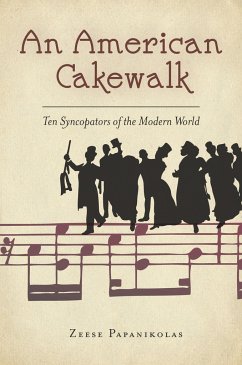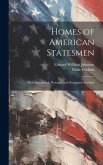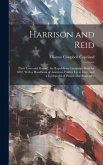21,99 €
inkl. MwSt.
Versandfertig in über 4 Wochen

11 °P sammeln
- Gebundenes Buch
- Merkliste
- Auf die Merkliste
- Bewerten Bewerten
- Teilen
- Produkt teilen
- Produkterinnerung
- Produkterinnerung
Zeese Papanikolas lives and works in Oakland, California. He is a former Stegner Fellow and long-time member of the Humanities Department at the San Francisco Art Institute. His writing includes Buried Unsung: Louis Tikas and the Ludlow Massacre (1982), Trickster in the Land of Dreams (1998), and American Silence (2007).
Andere Kunden interessierten sich auch für
![Amelia Earhart Amelia Earhart]() Doris L. RichAmelia Earhart20,99 €
Doris L. RichAmelia Earhart20,99 €![Homes of American Statesmen: With Anecdotical, Personal, and Descriptive Sketches Homes of American Statesmen: With Anecdotical, Personal, and Descriptive Sketches]() Parke GodwinHomes of American Statesmen: With Anecdotical, Personal, and Descriptive Sketches44,99 €
Parke GodwinHomes of American Statesmen: With Anecdotical, Personal, and Descriptive Sketches44,99 €![My American Roadtrip: From WWII to the 21st Century My American Roadtrip: From WWII to the 21st Century]() Andrew LudányiMy American Roadtrip: From WWII to the 21st Century52,99 €
Andrew LudányiMy American Roadtrip: From WWII to the 21st Century52,99 €![Harrison and Reid: Their Lives and Record. the Republican Campaign Book for 1892, With a Handbook of American Politics Up to Date, and a Harrison and Reid: Their Lives and Record. the Republican Campaign Book for 1892, With a Handbook of American Politics Up to Date, and a]() Thomas Campbell-CopelandHarrison and Reid: Their Lives and Record. the Republican Campaign Book for 1892, With a Handbook of American Politics Up to Date, and a45,99 €
Thomas Campbell-CopelandHarrison and Reid: Their Lives and Record. the Republican Campaign Book for 1892, With a Handbook of American Politics Up to Date, and a45,99 €![The American Letters of a Japanese Parlor-Maid The American Letters of a Japanese Parlor-Maid]() Yoné NoguchiThe American Letters of a Japanese Parlor-Maid37,99 €
Yoné NoguchiThe American Letters of a Japanese Parlor-Maid37,99 €![The American Manual and Patriot's Handbook The American Manual and Patriot's Handbook]() Samuel FallowsThe American Manual and Patriot's Handbook43,99 €
Samuel FallowsThe American Manual and Patriot's Handbook43,99 €![First Comes Marriage: My Not-So-Typical American Love Story First Comes Marriage: My Not-So-Typical American Love Story]() Huda Al-MarashiFirst Comes Marriage: My Not-So-Typical American Love Story22,99 €
Huda Al-MarashiFirst Comes Marriage: My Not-So-Typical American Love Story22,99 €-
-
-
Zeese Papanikolas lives and works in Oakland, California. He is a former Stegner Fellow and long-time member of the Humanities Department at the San Francisco Art Institute. His writing includes Buried Unsung: Louis Tikas and the Ludlow Massacre (1982), Trickster in the Land of Dreams (1998), and American Silence (2007).
Hinweis: Dieser Artikel kann nur an eine deutsche Lieferadresse ausgeliefert werden.
Hinweis: Dieser Artikel kann nur an eine deutsche Lieferadresse ausgeliefert werden.
Produktdetails
- Produktdetails
- Verlag: Stanford University Press
- Seitenzahl: 256
- Erscheinungstermin: 26. August 2015
- Englisch
- Abmessung: 231mm x 150mm x 13mm
- Gewicht: 454g
- ISBN-13: 9780804791991
- ISBN-10: 0804791996
- Artikelnr.: 42798489
- Herstellerkennzeichnung
- Libri GmbH
- Europaallee 1
- 36244 Bad Hersfeld
- 06621 890
- Verlag: Stanford University Press
- Seitenzahl: 256
- Erscheinungstermin: 26. August 2015
- Englisch
- Abmessung: 231mm x 150mm x 13mm
- Gewicht: 454g
- ISBN-13: 9780804791991
- ISBN-10: 0804791996
- Artikelnr.: 42798489
- Herstellerkennzeichnung
- Libri GmbH
- Europaallee 1
- 36244 Bad Hersfeld
- 06621 890
Zeese Papanikolas lives and works in Oakland, California. He is a former Stegner Fellow and long-time member of the Humanities Department at the San Francisco Art Institute. His writing includes Buried Unsung: Louis Tikas and the Ludlow Massacre (1982), Trickster in the Land of Dreams (1998), and American Silence (2007).
Contents and Abstracts
0Introduction
chapter abstract
The Introduction to the book presents the United States as an open-ended
dialogue of voices, classes, races and ethnicity. It introduces the
cakewalk as a model for a satiric intervention and opens the possibility of
style as a vessel of cultural subversion.
1Ghost Dance
chapter abstract
Chapter one shows the Native American trickster shaman as a cultural model
of survival and creative renewal in a hostile world. It gives a brief
history of 1890 Ghost Dance and the massacre of its Indian followers and
develops the idea of the Ghost Dance songs survival as a symbol of renewal.
The chapter concludes with a portrait of United States in 1890 as an
introduction to the historical and cultural context in which the cultural
innovators taken up in subsequent chapters.
2Valentines
chapter abstract
Chapter Two investigates the life of Emily Dickinson and quiet subversions
of her poetry. It emphasizes her manipulation of standard poetic forms and
religious expectations and the social platitudes of Victorian American
parlor poetry to produce sometimes dangerous but almost always surprising
revelations of passion, religious heterodoxy and poetic imagery.
3Cakewalk
chapter abstract
This chapter explains the 19th century slave dance the cakewalk and its
alliance with the syncopations of ragtime music to create unique place in
and reflection of African American life. It explores the cakewalk and
ragtime syncopation as satiric comment on the white world and as creative
resources. It explores the minstrel show as racial travesty and its role in
African American musical and theatrical idiom.
4Monsters
chapter abstract
Chapter three examines world of signs and contingency as developed by
Charles Sanders Peirce and exemplified by the work of Stephen Crane. It
takes up the characters of Peirce and Crane as reflected in their approach
to their separate fields.
5The Soul Shepherd.
chapter abstract
Chapter Five takes up William James as philosopher of the mind. It
describes his explorations of the limits of consciousness and his quest for
the realms spiritual in both his own life and as a philosopher of religion.
It examines his role in the development of the philosophy of pragmatism and
that philosophy's relation to his search for religious meaning. Finally,
Chapter Five takes up James's open-ended philosophy of radical empiricism.
6The Return of the Novelist
chapter abstract
This chapter is built around the novelist Henry James's return to America
in 1904 - 05 and his published and private writings about this journey. It
develops James's family life and position as an artist between two worlds,
Europe and America and how he made use of this position as a writer and
social thinker. His thoughts on the American South lead to a comparison to
another American social thinker, who found himself between two worlds and
two consciousnesses, his brother William's student W. E. B. DuBois. The
chapter concludes with James's method of oral composition in the final
stage of career and his championing of art as giving meaning to life.
7An Innocent at Cedro
chapter abstract
Chapter Seven takes up Thorstein Veblen and focuses on his anthropological
approach to economic theory. It examines his most famous work, The Theory
of the Leisure Class and its examination of conspicuous consumption in the
social world of America's wealthy movers and shakers and gives a picture of
Veblen as the consummate outsider. It sees his development the instincts of
workmanship and what he called idle curiosity as a challenge to the
prevailing deterministic ideas of cultural development and concludes with
Veblen's unsuccessful tenure as an engaged political and economic partisan.
8The Rise of Abraham Cahan
chapter abstract
Chapter Eight takes up the life of Jewish immigrant, writer and editor of
Abraham Cahan from the Old World to the New and his parallel creation of
David Levinsky in his seminal novel The Rise of David Levinsky. It
investigates the psychological commonalities beneath the socialist Cahan
and the successful capitalist Levinsky, and in so doing gives a portrait of
the social and psychological world of first generation of Jewish immigrants
at the end of the nineteenth century and into the twentieth. In their very
different ways successes, Cahan as the long-time editor of The Jewish Daily
Forward and his imaginary creation Levinsky as a millionaire clothing
manufacture, these two figures exemplify men caught between two worlds,
unsatisfied in each, and questioning the very meaning of success in
American life
9Beyond Syncopation
chapter abstract
This chapter looks at Jelly Roll Morton and his latter-day admirer, Charles
Mingus, and the role of race in their lives and in their pioneering jazz
innovation. It sees Morton as jazz's "first intellectual," who took jazz
from ragtime syncopation to open horizons of improvisation and true
composition,. The chapter sees Morton's unconscious as self-parody as a
precursor to Charles Mingus's psychological examination of his life as an
African-American man and its sexual and social constraints in Beneath the
Underdog. Mingus's exploitation of the liberating possibilities of a
ferocious vein of satire and avant-garde innovation in his music bring this
book to its conclusion.
0Introduction
chapter abstract
The Introduction to the book presents the United States as an open-ended
dialogue of voices, classes, races and ethnicity. It introduces the
cakewalk as a model for a satiric intervention and opens the possibility of
style as a vessel of cultural subversion.
1Ghost Dance
chapter abstract
Chapter one shows the Native American trickster shaman as a cultural model
of survival and creative renewal in a hostile world. It gives a brief
history of 1890 Ghost Dance and the massacre of its Indian followers and
develops the idea of the Ghost Dance songs survival as a symbol of renewal.
The chapter concludes with a portrait of United States in 1890 as an
introduction to the historical and cultural context in which the cultural
innovators taken up in subsequent chapters.
2Valentines
chapter abstract
Chapter Two investigates the life of Emily Dickinson and quiet subversions
of her poetry. It emphasizes her manipulation of standard poetic forms and
religious expectations and the social platitudes of Victorian American
parlor poetry to produce sometimes dangerous but almost always surprising
revelations of passion, religious heterodoxy and poetic imagery.
3Cakewalk
chapter abstract
This chapter explains the 19th century slave dance the cakewalk and its
alliance with the syncopations of ragtime music to create unique place in
and reflection of African American life. It explores the cakewalk and
ragtime syncopation as satiric comment on the white world and as creative
resources. It explores the minstrel show as racial travesty and its role in
African American musical and theatrical idiom.
4Monsters
chapter abstract
Chapter three examines world of signs and contingency as developed by
Charles Sanders Peirce and exemplified by the work of Stephen Crane. It
takes up the characters of Peirce and Crane as reflected in their approach
to their separate fields.
5The Soul Shepherd.
chapter abstract
Chapter Five takes up William James as philosopher of the mind. It
describes his explorations of the limits of consciousness and his quest for
the realms spiritual in both his own life and as a philosopher of religion.
It examines his role in the development of the philosophy of pragmatism and
that philosophy's relation to his search for religious meaning. Finally,
Chapter Five takes up James's open-ended philosophy of radical empiricism.
6The Return of the Novelist
chapter abstract
This chapter is built around the novelist Henry James's return to America
in 1904 - 05 and his published and private writings about this journey. It
develops James's family life and position as an artist between two worlds,
Europe and America and how he made use of this position as a writer and
social thinker. His thoughts on the American South lead to a comparison to
another American social thinker, who found himself between two worlds and
two consciousnesses, his brother William's student W. E. B. DuBois. The
chapter concludes with James's method of oral composition in the final
stage of career and his championing of art as giving meaning to life.
7An Innocent at Cedro
chapter abstract
Chapter Seven takes up Thorstein Veblen and focuses on his anthropological
approach to economic theory. It examines his most famous work, The Theory
of the Leisure Class and its examination of conspicuous consumption in the
social world of America's wealthy movers and shakers and gives a picture of
Veblen as the consummate outsider. It sees his development the instincts of
workmanship and what he called idle curiosity as a challenge to the
prevailing deterministic ideas of cultural development and concludes with
Veblen's unsuccessful tenure as an engaged political and economic partisan.
8The Rise of Abraham Cahan
chapter abstract
Chapter Eight takes up the life of Jewish immigrant, writer and editor of
Abraham Cahan from the Old World to the New and his parallel creation of
David Levinsky in his seminal novel The Rise of David Levinsky. It
investigates the psychological commonalities beneath the socialist Cahan
and the successful capitalist Levinsky, and in so doing gives a portrait of
the social and psychological world of first generation of Jewish immigrants
at the end of the nineteenth century and into the twentieth. In their very
different ways successes, Cahan as the long-time editor of The Jewish Daily
Forward and his imaginary creation Levinsky as a millionaire clothing
manufacture, these two figures exemplify men caught between two worlds,
unsatisfied in each, and questioning the very meaning of success in
American life
9Beyond Syncopation
chapter abstract
This chapter looks at Jelly Roll Morton and his latter-day admirer, Charles
Mingus, and the role of race in their lives and in their pioneering jazz
innovation. It sees Morton as jazz's "first intellectual," who took jazz
from ragtime syncopation to open horizons of improvisation and true
composition,. The chapter sees Morton's unconscious as self-parody as a
precursor to Charles Mingus's psychological examination of his life as an
African-American man and its sexual and social constraints in Beneath the
Underdog. Mingus's exploitation of the liberating possibilities of a
ferocious vein of satire and avant-garde innovation in his music bring this
book to its conclusion.
Contents and Abstracts
0Introduction
chapter abstract
The Introduction to the book presents the United States as an open-ended
dialogue of voices, classes, races and ethnicity. It introduces the
cakewalk as a model for a satiric intervention and opens the possibility of
style as a vessel of cultural subversion.
1Ghost Dance
chapter abstract
Chapter one shows the Native American trickster shaman as a cultural model
of survival and creative renewal in a hostile world. It gives a brief
history of 1890 Ghost Dance and the massacre of its Indian followers and
develops the idea of the Ghost Dance songs survival as a symbol of renewal.
The chapter concludes with a portrait of United States in 1890 as an
introduction to the historical and cultural context in which the cultural
innovators taken up in subsequent chapters.
2Valentines
chapter abstract
Chapter Two investigates the life of Emily Dickinson and quiet subversions
of her poetry. It emphasizes her manipulation of standard poetic forms and
religious expectations and the social platitudes of Victorian American
parlor poetry to produce sometimes dangerous but almost always surprising
revelations of passion, religious heterodoxy and poetic imagery.
3Cakewalk
chapter abstract
This chapter explains the 19th century slave dance the cakewalk and its
alliance with the syncopations of ragtime music to create unique place in
and reflection of African American life. It explores the cakewalk and
ragtime syncopation as satiric comment on the white world and as creative
resources. It explores the minstrel show as racial travesty and its role in
African American musical and theatrical idiom.
4Monsters
chapter abstract
Chapter three examines world of signs and contingency as developed by
Charles Sanders Peirce and exemplified by the work of Stephen Crane. It
takes up the characters of Peirce and Crane as reflected in their approach
to their separate fields.
5The Soul Shepherd.
chapter abstract
Chapter Five takes up William James as philosopher of the mind. It
describes his explorations of the limits of consciousness and his quest for
the realms spiritual in both his own life and as a philosopher of religion.
It examines his role in the development of the philosophy of pragmatism and
that philosophy's relation to his search for religious meaning. Finally,
Chapter Five takes up James's open-ended philosophy of radical empiricism.
6The Return of the Novelist
chapter abstract
This chapter is built around the novelist Henry James's return to America
in 1904 - 05 and his published and private writings about this journey. It
develops James's family life and position as an artist between two worlds,
Europe and America and how he made use of this position as a writer and
social thinker. His thoughts on the American South lead to a comparison to
another American social thinker, who found himself between two worlds and
two consciousnesses, his brother William's student W. E. B. DuBois. The
chapter concludes with James's method of oral composition in the final
stage of career and his championing of art as giving meaning to life.
7An Innocent at Cedro
chapter abstract
Chapter Seven takes up Thorstein Veblen and focuses on his anthropological
approach to economic theory. It examines his most famous work, The Theory
of the Leisure Class and its examination of conspicuous consumption in the
social world of America's wealthy movers and shakers and gives a picture of
Veblen as the consummate outsider. It sees his development the instincts of
workmanship and what he called idle curiosity as a challenge to the
prevailing deterministic ideas of cultural development and concludes with
Veblen's unsuccessful tenure as an engaged political and economic partisan.
8The Rise of Abraham Cahan
chapter abstract
Chapter Eight takes up the life of Jewish immigrant, writer and editor of
Abraham Cahan from the Old World to the New and his parallel creation of
David Levinsky in his seminal novel The Rise of David Levinsky. It
investigates the psychological commonalities beneath the socialist Cahan
and the successful capitalist Levinsky, and in so doing gives a portrait of
the social and psychological world of first generation of Jewish immigrants
at the end of the nineteenth century and into the twentieth. In their very
different ways successes, Cahan as the long-time editor of The Jewish Daily
Forward and his imaginary creation Levinsky as a millionaire clothing
manufacture, these two figures exemplify men caught between two worlds,
unsatisfied in each, and questioning the very meaning of success in
American life
9Beyond Syncopation
chapter abstract
This chapter looks at Jelly Roll Morton and his latter-day admirer, Charles
Mingus, and the role of race in their lives and in their pioneering jazz
innovation. It sees Morton as jazz's "first intellectual," who took jazz
from ragtime syncopation to open horizons of improvisation and true
composition,. The chapter sees Morton's unconscious as self-parody as a
precursor to Charles Mingus's psychological examination of his life as an
African-American man and its sexual and social constraints in Beneath the
Underdog. Mingus's exploitation of the liberating possibilities of a
ferocious vein of satire and avant-garde innovation in his music bring this
book to its conclusion.
0Introduction
chapter abstract
The Introduction to the book presents the United States as an open-ended
dialogue of voices, classes, races and ethnicity. It introduces the
cakewalk as a model for a satiric intervention and opens the possibility of
style as a vessel of cultural subversion.
1Ghost Dance
chapter abstract
Chapter one shows the Native American trickster shaman as a cultural model
of survival and creative renewal in a hostile world. It gives a brief
history of 1890 Ghost Dance and the massacre of its Indian followers and
develops the idea of the Ghost Dance songs survival as a symbol of renewal.
The chapter concludes with a portrait of United States in 1890 as an
introduction to the historical and cultural context in which the cultural
innovators taken up in subsequent chapters.
2Valentines
chapter abstract
Chapter Two investigates the life of Emily Dickinson and quiet subversions
of her poetry. It emphasizes her manipulation of standard poetic forms and
religious expectations and the social platitudes of Victorian American
parlor poetry to produce sometimes dangerous but almost always surprising
revelations of passion, religious heterodoxy and poetic imagery.
3Cakewalk
chapter abstract
This chapter explains the 19th century slave dance the cakewalk and its
alliance with the syncopations of ragtime music to create unique place in
and reflection of African American life. It explores the cakewalk and
ragtime syncopation as satiric comment on the white world and as creative
resources. It explores the minstrel show as racial travesty and its role in
African American musical and theatrical idiom.
4Monsters
chapter abstract
Chapter three examines world of signs and contingency as developed by
Charles Sanders Peirce and exemplified by the work of Stephen Crane. It
takes up the characters of Peirce and Crane as reflected in their approach
to their separate fields.
5The Soul Shepherd.
chapter abstract
Chapter Five takes up William James as philosopher of the mind. It
describes his explorations of the limits of consciousness and his quest for
the realms spiritual in both his own life and as a philosopher of religion.
It examines his role in the development of the philosophy of pragmatism and
that philosophy's relation to his search for religious meaning. Finally,
Chapter Five takes up James's open-ended philosophy of radical empiricism.
6The Return of the Novelist
chapter abstract
This chapter is built around the novelist Henry James's return to America
in 1904 - 05 and his published and private writings about this journey. It
develops James's family life and position as an artist between two worlds,
Europe and America and how he made use of this position as a writer and
social thinker. His thoughts on the American South lead to a comparison to
another American social thinker, who found himself between two worlds and
two consciousnesses, his brother William's student W. E. B. DuBois. The
chapter concludes with James's method of oral composition in the final
stage of career and his championing of art as giving meaning to life.
7An Innocent at Cedro
chapter abstract
Chapter Seven takes up Thorstein Veblen and focuses on his anthropological
approach to economic theory. It examines his most famous work, The Theory
of the Leisure Class and its examination of conspicuous consumption in the
social world of America's wealthy movers and shakers and gives a picture of
Veblen as the consummate outsider. It sees his development the instincts of
workmanship and what he called idle curiosity as a challenge to the
prevailing deterministic ideas of cultural development and concludes with
Veblen's unsuccessful tenure as an engaged political and economic partisan.
8The Rise of Abraham Cahan
chapter abstract
Chapter Eight takes up the life of Jewish immigrant, writer and editor of
Abraham Cahan from the Old World to the New and his parallel creation of
David Levinsky in his seminal novel The Rise of David Levinsky. It
investigates the psychological commonalities beneath the socialist Cahan
and the successful capitalist Levinsky, and in so doing gives a portrait of
the social and psychological world of first generation of Jewish immigrants
at the end of the nineteenth century and into the twentieth. In their very
different ways successes, Cahan as the long-time editor of The Jewish Daily
Forward and his imaginary creation Levinsky as a millionaire clothing
manufacture, these two figures exemplify men caught between two worlds,
unsatisfied in each, and questioning the very meaning of success in
American life
9Beyond Syncopation
chapter abstract
This chapter looks at Jelly Roll Morton and his latter-day admirer, Charles
Mingus, and the role of race in their lives and in their pioneering jazz
innovation. It sees Morton as jazz's "first intellectual," who took jazz
from ragtime syncopation to open horizons of improvisation and true
composition,. The chapter sees Morton's unconscious as self-parody as a
precursor to Charles Mingus's psychological examination of his life as an
African-American man and its sexual and social constraints in Beneath the
Underdog. Mingus's exploitation of the liberating possibilities of a
ferocious vein of satire and avant-garde innovation in his music bring this
book to its conclusion.







